Communication Challenges and Solutions in Global Virtual Teams Report
VerifiedAdded on 2022/11/01
|12
|3974
|263
Report
AI Summary
This report provides a comprehensive analysis of global virtual teams (GVTs), emphasizing their definition, characteristics, and the communication challenges they face. It highlights the benefits of GVTs, such as access to a global talent pool and 24/7 work capabilities, while also addressing the complexities of communication, including linguistic barriers, cultural diversity, technology dependency due to geographical dispersion, and lack of standardized processes. The report delves into the characteristics of GVTs, which include communication through technology, cultural diversification, and a strong emphasis on collaboration. It then identifies and examines specific communication problems, such as those stemming from cultural diversity, dependency on technology, and the absence of clear processes. The report concludes by offering practical management strategies to mitigate these challenges, thereby improving team performance and achieving organizational goals. The report provides solutions to cultural diversity, technology dependency and lack of process. The report provides a detailed analysis and management strategies for solving these problems with detailed analysis.

Running head: GLOBAL VIRTUAL TEAMS
Global Virtual Teams
Name of the Student
Name of the University
Author’s Note:
Global Virtual Teams
Name of the Student
Name of the University
Author’s Note:
Paraphrase This Document
Need a fresh take? Get an instant paraphrase of this document with our AI Paraphraser

1
GLOBAL VIRTUAL TEAMS
EXECUTIVE SUMMARY
The major objective of the report is to understand about global virtual team. This kind of
team adopt the major concept that each and every team member could easily engage in and
even meet the objectives with no direct physical cooperation with any other member and
thus enabling the multinational organizations in drawing on the broadest and largest talent
pool that is available amongst the worldwide base of staff. For effectively undertaking the
benefits of globalized teams, the respective members try to understand the complexities,
faced by them. They have the core potential for reaping the same business related
advantages while working a culturally diversified working place. The first and the foremost
advantage of GVT is that they allow the company is searching for a wide variety of top
talents globally. The second important and distinct advantage of such team is that they can
work 24 * 7. Due to the dispersed geographical locations, time management and time
flexibility is quite high these teams and thus it becomes quite easy to eradicate complexities
related to time. Hence, there exists a continuous work flow in the team.
A GVT also helps in maximizing resources and for the busy schedules, the core benefit for
globalized talent pool is helpful for the company in keeping their customers highly satisfied
after successfully increasing the production rates. The main three characteristics of a global
virtual team include communication with technologies, better collaboration and major cultural
diversification. These three above mentioned characteristics are responsible for the entire
team absolutely different and distinguishable in comparison to the face-to-face meetings or
teams. In spite of having such distinctive advantages, a GVT often faces issues related to
communication. The first and the most distinctive communication issue is linguistic barrier as
different team members belong to different parts of the world. The main reason to this
communication problem is cultural diversification. The second communication issue is
dependency on technology. The reason for such issues is geographical dispersion amongst
the team members. The third distinctive communication problem is lack of process or rules in
the team. This report has provided suitable management strategies for solving these
communication problems in a GVT.
GLOBAL VIRTUAL TEAMS
EXECUTIVE SUMMARY
The major objective of the report is to understand about global virtual team. This kind of
team adopt the major concept that each and every team member could easily engage in and
even meet the objectives with no direct physical cooperation with any other member and
thus enabling the multinational organizations in drawing on the broadest and largest talent
pool that is available amongst the worldwide base of staff. For effectively undertaking the
benefits of globalized teams, the respective members try to understand the complexities,
faced by them. They have the core potential for reaping the same business related
advantages while working a culturally diversified working place. The first and the foremost
advantage of GVT is that they allow the company is searching for a wide variety of top
talents globally. The second important and distinct advantage of such team is that they can
work 24 * 7. Due to the dispersed geographical locations, time management and time
flexibility is quite high these teams and thus it becomes quite easy to eradicate complexities
related to time. Hence, there exists a continuous work flow in the team.
A GVT also helps in maximizing resources and for the busy schedules, the core benefit for
globalized talent pool is helpful for the company in keeping their customers highly satisfied
after successfully increasing the production rates. The main three characteristics of a global
virtual team include communication with technologies, better collaboration and major cultural
diversification. These three above mentioned characteristics are responsible for the entire
team absolutely different and distinguishable in comparison to the face-to-face meetings or
teams. In spite of having such distinctive advantages, a GVT often faces issues related to
communication. The first and the most distinctive communication issue is linguistic barrier as
different team members belong to different parts of the world. The main reason to this
communication problem is cultural diversification. The second communication issue is
dependency on technology. The reason for such issues is geographical dispersion amongst
the team members. The third distinctive communication problem is lack of process or rules in
the team. This report has provided suitable management strategies for solving these
communication problems in a GVT.

2
GLOBAL VIRTUAL TEAMS
Table of Contents
1.0 INTRODUCTION..............................................................................................................3
2.0 DEFINITION OF GLOBAL VIRTUAL TEAMS...................................................................3
3.0 CHARACTERISTICS OF GVTs........................................................................................3
3.1 Communication with Technology..................................................................................3
3.2 Cultural Diversification..................................................................................................3
3.3 Collaboration.................................................................................................................3
4.0 COMMUNICATION PROBLEMS......................................................................................4
4.1 Cultural Diversity...........................................................................................................4
4.2 Dependency on Technology due to Geographical Dispersion.......................................5
4.3 Lack of Process............................................................................................................ 5
5.0 MANAGEMENT STRATEGIES........................................................................................6
5.1 Solution to Cultural Diversity.........................................................................................7
5.2 Solution to Dependency on Technology due to Geographical Dispersion.....................7
5.3 Solution to Lack of Process..........................................................................................8
6.0 CONCLUSION................................................................................................................. 8
Reference List........................................................................................................................ 9
GLOBAL VIRTUAL TEAMS
Table of Contents
1.0 INTRODUCTION..............................................................................................................3
2.0 DEFINITION OF GLOBAL VIRTUAL TEAMS...................................................................3
3.0 CHARACTERISTICS OF GVTs........................................................................................3
3.1 Communication with Technology..................................................................................3
3.2 Cultural Diversification..................................................................................................3
3.3 Collaboration.................................................................................................................3
4.0 COMMUNICATION PROBLEMS......................................................................................4
4.1 Cultural Diversity...........................................................................................................4
4.2 Dependency on Technology due to Geographical Dispersion.......................................5
4.3 Lack of Process............................................................................................................ 5
5.0 MANAGEMENT STRATEGIES........................................................................................6
5.1 Solution to Cultural Diversity.........................................................................................7
5.2 Solution to Dependency on Technology due to Geographical Dispersion.....................7
5.3 Solution to Lack of Process..........................................................................................8
6.0 CONCLUSION................................................................................................................. 8
Reference List........................................................................................................................ 9
⊘ This is a preview!⊘
Do you want full access?
Subscribe today to unlock all pages.

Trusted by 1+ million students worldwide

3
GLOBAL VIRTUAL TEAMS
1.0 INTRODUCTION
Global virtual team (GVT) is a team of members, who work altogether from various
geographical locations and remain completely dependent on methods of communication
technologies. The most common types of communication technologies include fax, video
conferences, electronic mails and few others for effectively collaborate amongst each other.
Such teams comprise of organizationally as well as time dispersed members and they are
brought altogether by incorporation of ICT for accomplishing several organizational tasks
(Stawnicza, 2014). However, there are few issues, which are often faced within such teams
related to communication and such issues are needed to be resolved under every
circumstance. This report would be providing a detailed analysis on GVTs with proper
definition, main characteristics, communication problems and management strategies for
solving these problems with detailed analysis.
2.0 DEFINITION OF GLOBAL VIRTUAL TEAMS
“Global virtual teams are based on individuals collaborating in geographically
dispersed work groups and who may reside in different time zones and countries” (Klitmøller
& Lauring, 2013, p. 1).
According to Klitmøller and Lauring (2013), global virtual teams are those teams, in
which members collaborate in geographical dispersed teams and even reside in separate
countries and time zones (p. 1).
3.0 CHARACTERISTICS OF GVTs
Three characteristics that help to distinguish a GVT from other face to face team are
provided below:
3.1 Communication with Technology
GVTs never meet face-to-face, thus it is required for them to communicate through
technology. It influences the team members in reducing complexities related to
communication and ensuring that geographical dispersion is not affecting the overall
communication spectrum under any circumstance.
3.2 Cultural Diversification
GVTs are culturally diversified teams since these members of team belong to
separate locations of world (Shachaf, 2008). Moreover, it enhances organizational
productivity and growth to a high level as well as emphasizes on globalization.
GLOBAL VIRTUAL TEAMS
1.0 INTRODUCTION
Global virtual team (GVT) is a team of members, who work altogether from various
geographical locations and remain completely dependent on methods of communication
technologies. The most common types of communication technologies include fax, video
conferences, electronic mails and few others for effectively collaborate amongst each other.
Such teams comprise of organizationally as well as time dispersed members and they are
brought altogether by incorporation of ICT for accomplishing several organizational tasks
(Stawnicza, 2014). However, there are few issues, which are often faced within such teams
related to communication and such issues are needed to be resolved under every
circumstance. This report would be providing a detailed analysis on GVTs with proper
definition, main characteristics, communication problems and management strategies for
solving these problems with detailed analysis.
2.0 DEFINITION OF GLOBAL VIRTUAL TEAMS
“Global virtual teams are based on individuals collaborating in geographically
dispersed work groups and who may reside in different time zones and countries” (Klitmøller
& Lauring, 2013, p. 1).
According to Klitmøller and Lauring (2013), global virtual teams are those teams, in
which members collaborate in geographical dispersed teams and even reside in separate
countries and time zones (p. 1).
3.0 CHARACTERISTICS OF GVTs
Three characteristics that help to distinguish a GVT from other face to face team are
provided below:
3.1 Communication with Technology
GVTs never meet face-to-face, thus it is required for them to communicate through
technology. It influences the team members in reducing complexities related to
communication and ensuring that geographical dispersion is not affecting the overall
communication spectrum under any circumstance.
3.2 Cultural Diversification
GVTs are culturally diversified teams since these members of team belong to
separate locations of world (Shachaf, 2008). Moreover, it enhances organizational
productivity and growth to a high level as well as emphasizes on globalization.
Paraphrase This Document
Need a fresh take? Get an instant paraphrase of this document with our AI Paraphraser
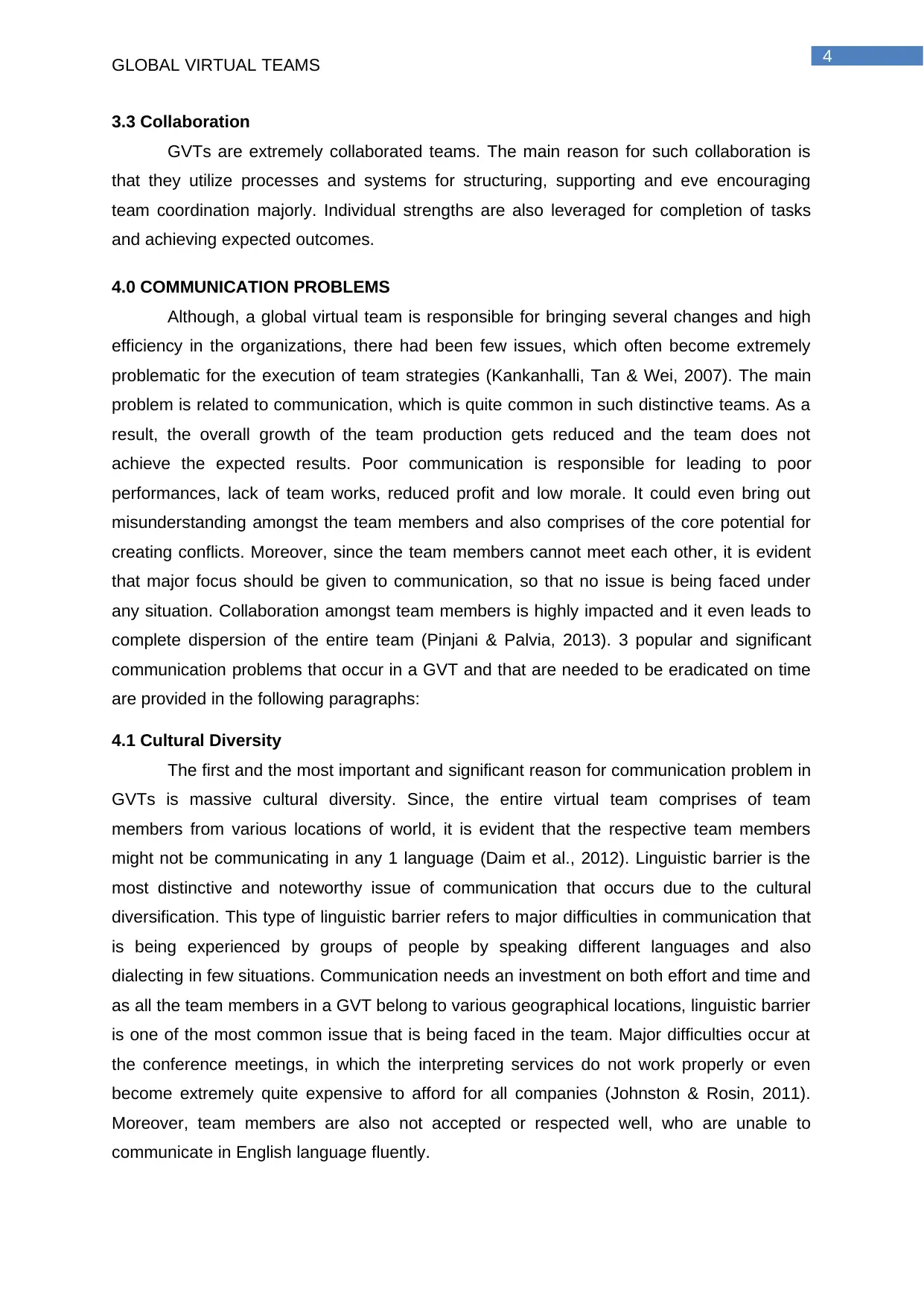
4
GLOBAL VIRTUAL TEAMS
3.3 Collaboration
GVTs are extremely collaborated teams. The main reason for such collaboration is
that they utilize processes and systems for structuring, supporting and eve encouraging
team coordination majorly. Individual strengths are also leveraged for completion of tasks
and achieving expected outcomes.
4.0 COMMUNICATION PROBLEMS
Although, a global virtual team is responsible for bringing several changes and high
efficiency in the organizations, there had been few issues, which often become extremely
problematic for the execution of team strategies (Kankanhalli, Tan & Wei, 2007). The main
problem is related to communication, which is quite common in such distinctive teams. As a
result, the overall growth of the team production gets reduced and the team does not
achieve the expected results. Poor communication is responsible for leading to poor
performances, lack of team works, reduced profit and low morale. It could even bring out
misunderstanding amongst the team members and also comprises of the core potential for
creating conflicts. Moreover, since the team members cannot meet each other, it is evident
that major focus should be given to communication, so that no issue is being faced under
any situation. Collaboration amongst team members is highly impacted and it even leads to
complete dispersion of the entire team (Pinjani & Palvia, 2013). 3 popular and significant
communication problems that occur in a GVT and that are needed to be eradicated on time
are provided in the following paragraphs:
4.1 Cultural Diversity
The first and the most important and significant reason for communication problem in
GVTs is massive cultural diversity. Since, the entire virtual team comprises of team
members from various locations of world, it is evident that the respective team members
might not be communicating in any 1 language (Daim et al., 2012). Linguistic barrier is the
most distinctive and noteworthy issue of communication that occurs due to the cultural
diversification. This type of linguistic barrier refers to major difficulties in communication that
is being experienced by groups of people by speaking different languages and also
dialecting in few situations. Communication needs an investment on both effort and time and
as all the team members in a GVT belong to various geographical locations, linguistic barrier
is one of the most common issue that is being faced in the team. Major difficulties occur at
the conference meetings, in which the interpreting services do not work properly or even
become extremely quite expensive to afford for all companies (Johnston & Rosin, 2011).
Moreover, team members are also not accepted or respected well, who are unable to
communicate in English language fluently.
GLOBAL VIRTUAL TEAMS
3.3 Collaboration
GVTs are extremely collaborated teams. The main reason for such collaboration is
that they utilize processes and systems for structuring, supporting and eve encouraging
team coordination majorly. Individual strengths are also leveraged for completion of tasks
and achieving expected outcomes.
4.0 COMMUNICATION PROBLEMS
Although, a global virtual team is responsible for bringing several changes and high
efficiency in the organizations, there had been few issues, which often become extremely
problematic for the execution of team strategies (Kankanhalli, Tan & Wei, 2007). The main
problem is related to communication, which is quite common in such distinctive teams. As a
result, the overall growth of the team production gets reduced and the team does not
achieve the expected results. Poor communication is responsible for leading to poor
performances, lack of team works, reduced profit and low morale. It could even bring out
misunderstanding amongst the team members and also comprises of the core potential for
creating conflicts. Moreover, since the team members cannot meet each other, it is evident
that major focus should be given to communication, so that no issue is being faced under
any situation. Collaboration amongst team members is highly impacted and it even leads to
complete dispersion of the entire team (Pinjani & Palvia, 2013). 3 popular and significant
communication problems that occur in a GVT and that are needed to be eradicated on time
are provided in the following paragraphs:
4.1 Cultural Diversity
The first and the most important and significant reason for communication problem in
GVTs is massive cultural diversity. Since, the entire virtual team comprises of team
members from various locations of world, it is evident that the respective team members
might not be communicating in any 1 language (Daim et al., 2012). Linguistic barrier is the
most distinctive and noteworthy issue of communication that occurs due to the cultural
diversification. This type of linguistic barrier refers to major difficulties in communication that
is being experienced by groups of people by speaking different languages and also
dialecting in few situations. Communication needs an investment on both effort and time and
as all the team members in a GVT belong to various geographical locations, linguistic barrier
is one of the most common issue that is being faced in the team. Major difficulties occur at
the conference meetings, in which the interpreting services do not work properly or even
become extremely quite expensive to afford for all companies (Johnston & Rosin, 2011).
Moreover, team members are also not accepted or respected well, who are unable to
communicate in English language fluently.

5
GLOBAL VIRTUAL TEAMS
This particular fundamental value can contribute to the most successful diversified
work place amongst employees. The second issue that is also common due to
communication problem in a cultural diversified team is ethnic as well as cultural difference.
It is extremely common that these team members are unable to match or reduce cultural
difference and it is highly impacting the overall team growth and development in a higher
level (Morgan, Paucar-Caceres & Wright, 2014). There is a high accommodation of beliefs
that these teams could not get the scope for communicating efficiently as language training
for non-native English speakers eventually prevent communication. As a result,
miscommunication takes place and there is a huge loss in productivity of the company.
Increasing diversification in work place would be quite advantageous in the organization for
long run.
4.2 Dependency on Technology due to Geographical Dispersion
The next issue of communication, which is being faced in a GVT is dependency over
technology for subsequent geographical distribution (Derven, 2016). Since, these teams
could not eventually execute the communication via various modes of technology, such
teams are completely dependent on technological advancements and they could not achieve
their business goals and objectives by not involving technologies under any circumstance. A
recent advancement within the respective networking environment and telecommunications
has substantially led in propagating the GVTs that these teams are not completing their work
in face to face interactions or meetings and are making interactions with the help of
computer based communications’ networks (Killingsworth, Xue & Liu, 2016). The major as
well as the most popular modes of such communication in the GVT include video
conferencing and audio conferencing. As a result, there exists high chance of sequential
communication and better visibility in these above stated communication methods.
A GVT even provides proper opportunities to the respective company, under which
the team is working. These various kinds of communication methods are responsible for
providing different and significant benefits to the teams, a continuous dependency is being
observed on the communication method and hence bringing complexities and issues for this
particular geographically dispersed team (Magnusson, Schuster & Taras, 2014).
Furthermore, such distinctive teams are even solely dependent on the Internet connectivity,
since each and every meeting gets arranged through such connections and technological
advancements. It would ensure that high efficacy and effectiveness is being observed in the
organization, however due to such dependency, the team becomes completely non
functional without incorporation of the Internet connectivity and other technological products,
such projectors, servers, computer systems and many more.
GLOBAL VIRTUAL TEAMS
This particular fundamental value can contribute to the most successful diversified
work place amongst employees. The second issue that is also common due to
communication problem in a cultural diversified team is ethnic as well as cultural difference.
It is extremely common that these team members are unable to match or reduce cultural
difference and it is highly impacting the overall team growth and development in a higher
level (Morgan, Paucar-Caceres & Wright, 2014). There is a high accommodation of beliefs
that these teams could not get the scope for communicating efficiently as language training
for non-native English speakers eventually prevent communication. As a result,
miscommunication takes place and there is a huge loss in productivity of the company.
Increasing diversification in work place would be quite advantageous in the organization for
long run.
4.2 Dependency on Technology due to Geographical Dispersion
The next issue of communication, which is being faced in a GVT is dependency over
technology for subsequent geographical distribution (Derven, 2016). Since, these teams
could not eventually execute the communication via various modes of technology, such
teams are completely dependent on technological advancements and they could not achieve
their business goals and objectives by not involving technologies under any circumstance. A
recent advancement within the respective networking environment and telecommunications
has substantially led in propagating the GVTs that these teams are not completing their work
in face to face interactions or meetings and are making interactions with the help of
computer based communications’ networks (Killingsworth, Xue & Liu, 2016). The major as
well as the most popular modes of such communication in the GVT include video
conferencing and audio conferencing. As a result, there exists high chance of sequential
communication and better visibility in these above stated communication methods.
A GVT even provides proper opportunities to the respective company, under which
the team is working. These various kinds of communication methods are responsible for
providing different and significant benefits to the teams, a continuous dependency is being
observed on the communication method and hence bringing complexities and issues for this
particular geographically dispersed team (Magnusson, Schuster & Taras, 2014).
Furthermore, such distinctive teams are even solely dependent on the Internet connectivity,
since each and every meeting gets arranged through such connections and technological
advancements. It would ensure that high efficacy and effectiveness is being observed in the
organization, however due to such dependency, the team becomes completely non
functional without incorporation of the Internet connectivity and other technological products,
such projectors, servers, computer systems and many more.
⊘ This is a preview!⊘
Do you want full access?
Subscribe today to unlock all pages.

Trusted by 1+ million students worldwide
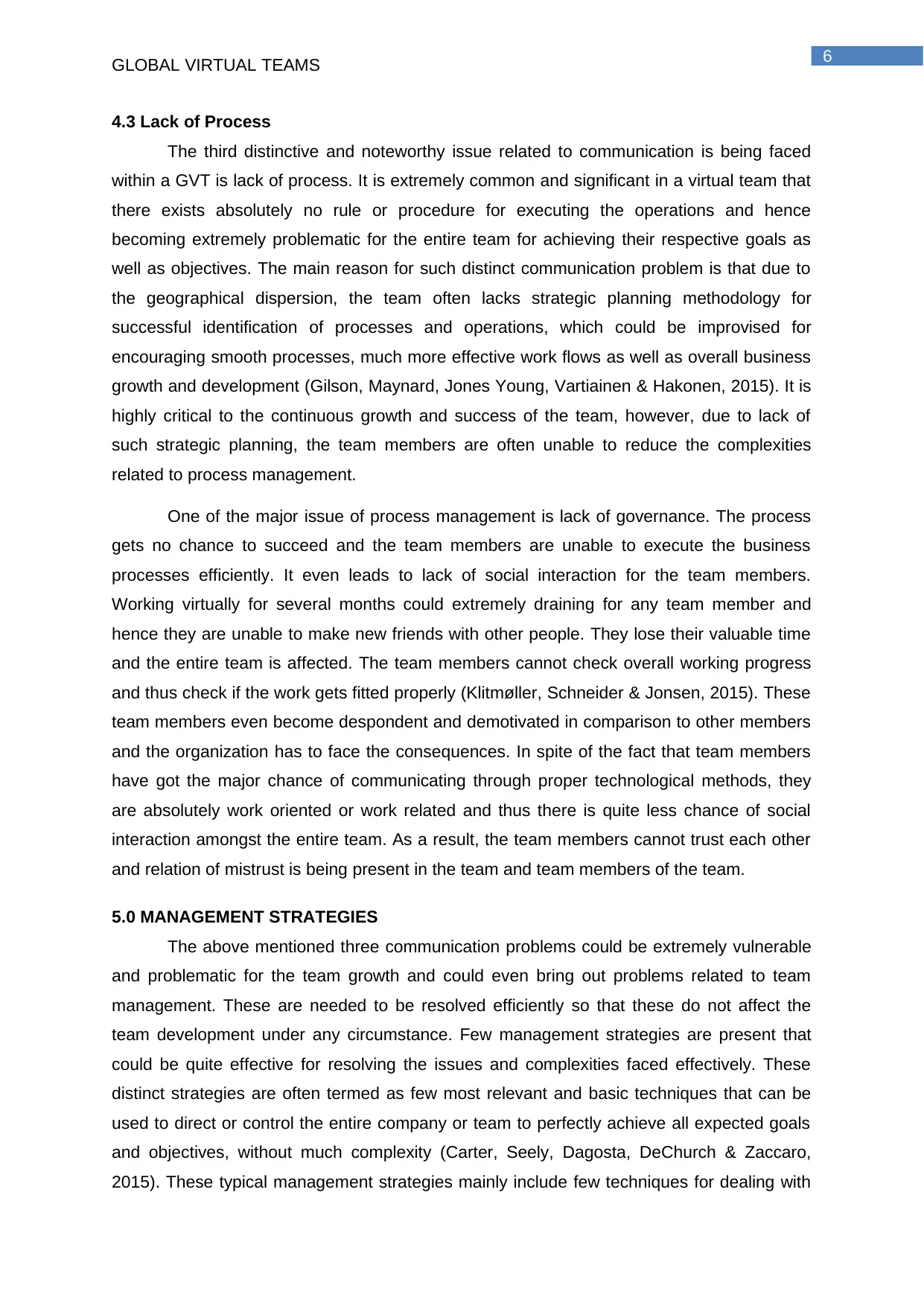
6
GLOBAL VIRTUAL TEAMS
4.3 Lack of Process
The third distinctive and noteworthy issue related to communication is being faced
within a GVT is lack of process. It is extremely common and significant in a virtual team that
there exists absolutely no rule or procedure for executing the operations and hence
becoming extremely problematic for the entire team for achieving their respective goals as
well as objectives. The main reason for such distinct communication problem is that due to
the geographical dispersion, the team often lacks strategic planning methodology for
successful identification of processes and operations, which could be improvised for
encouraging smooth processes, much more effective work flows as well as overall business
growth and development (Gilson, Maynard, Jones Young, Vartiainen & Hakonen, 2015). It is
highly critical to the continuous growth and success of the team, however, due to lack of
such strategic planning, the team members are often unable to reduce the complexities
related to process management.
One of the major issue of process management is lack of governance. The process
gets no chance to succeed and the team members are unable to execute the business
processes efficiently. It even leads to lack of social interaction for the team members.
Working virtually for several months could extremely draining for any team member and
hence they are unable to make new friends with other people. They lose their valuable time
and the entire team is affected. The team members cannot check overall working progress
and thus check if the work gets fitted properly (Klitmøller, Schneider & Jonsen, 2015). These
team members even become despondent and demotivated in comparison to other members
and the organization has to face the consequences. In spite of the fact that team members
have got the major chance of communicating through proper technological methods, they
are absolutely work oriented or work related and thus there is quite less chance of social
interaction amongst the entire team. As a result, the team members cannot trust each other
and relation of mistrust is being present in the team and team members of the team.
5.0 MANAGEMENT STRATEGIES
The above mentioned three communication problems could be extremely vulnerable
and problematic for the team growth and could even bring out problems related to team
management. These are needed to be resolved efficiently so that these do not affect the
team development under any circumstance. Few management strategies are present that
could be quite effective for resolving the issues and complexities faced effectively. These
distinct strategies are often termed as few most relevant and basic techniques that can be
used to direct or control the entire company or team to perfectly achieve all expected goals
and objectives, without much complexity (Carter, Seely, Dagosta, DeChurch & Zaccaro,
2015). These typical management strategies mainly include few techniques for dealing with
GLOBAL VIRTUAL TEAMS
4.3 Lack of Process
The third distinctive and noteworthy issue related to communication is being faced
within a GVT is lack of process. It is extremely common and significant in a virtual team that
there exists absolutely no rule or procedure for executing the operations and hence
becoming extremely problematic for the entire team for achieving their respective goals as
well as objectives. The main reason for such distinct communication problem is that due to
the geographical dispersion, the team often lacks strategic planning methodology for
successful identification of processes and operations, which could be improvised for
encouraging smooth processes, much more effective work flows as well as overall business
growth and development (Gilson, Maynard, Jones Young, Vartiainen & Hakonen, 2015). It is
highly critical to the continuous growth and success of the team, however, due to lack of
such strategic planning, the team members are often unable to reduce the complexities
related to process management.
One of the major issue of process management is lack of governance. The process
gets no chance to succeed and the team members are unable to execute the business
processes efficiently. It even leads to lack of social interaction for the team members.
Working virtually for several months could extremely draining for any team member and
hence they are unable to make new friends with other people. They lose their valuable time
and the entire team is affected. The team members cannot check overall working progress
and thus check if the work gets fitted properly (Klitmøller, Schneider & Jonsen, 2015). These
team members even become despondent and demotivated in comparison to other members
and the organization has to face the consequences. In spite of the fact that team members
have got the major chance of communicating through proper technological methods, they
are absolutely work oriented or work related and thus there is quite less chance of social
interaction amongst the entire team. As a result, the team members cannot trust each other
and relation of mistrust is being present in the team and team members of the team.
5.0 MANAGEMENT STRATEGIES
The above mentioned three communication problems could be extremely vulnerable
and problematic for the team growth and could even bring out problems related to team
management. These are needed to be resolved efficiently so that these do not affect the
team development under any circumstance. Few management strategies are present that
could be quite effective for resolving the issues and complexities faced effectively. These
distinct strategies are often termed as few most relevant and basic techniques that can be
used to direct or control the entire company or team to perfectly achieve all expected goals
and objectives, without much complexity (Carter, Seely, Dagosta, DeChurch & Zaccaro,
2015). These typical management strategies mainly include few techniques for dealing with
Paraphrase This Document
Need a fresh take? Get an instant paraphrase of this document with our AI Paraphraser
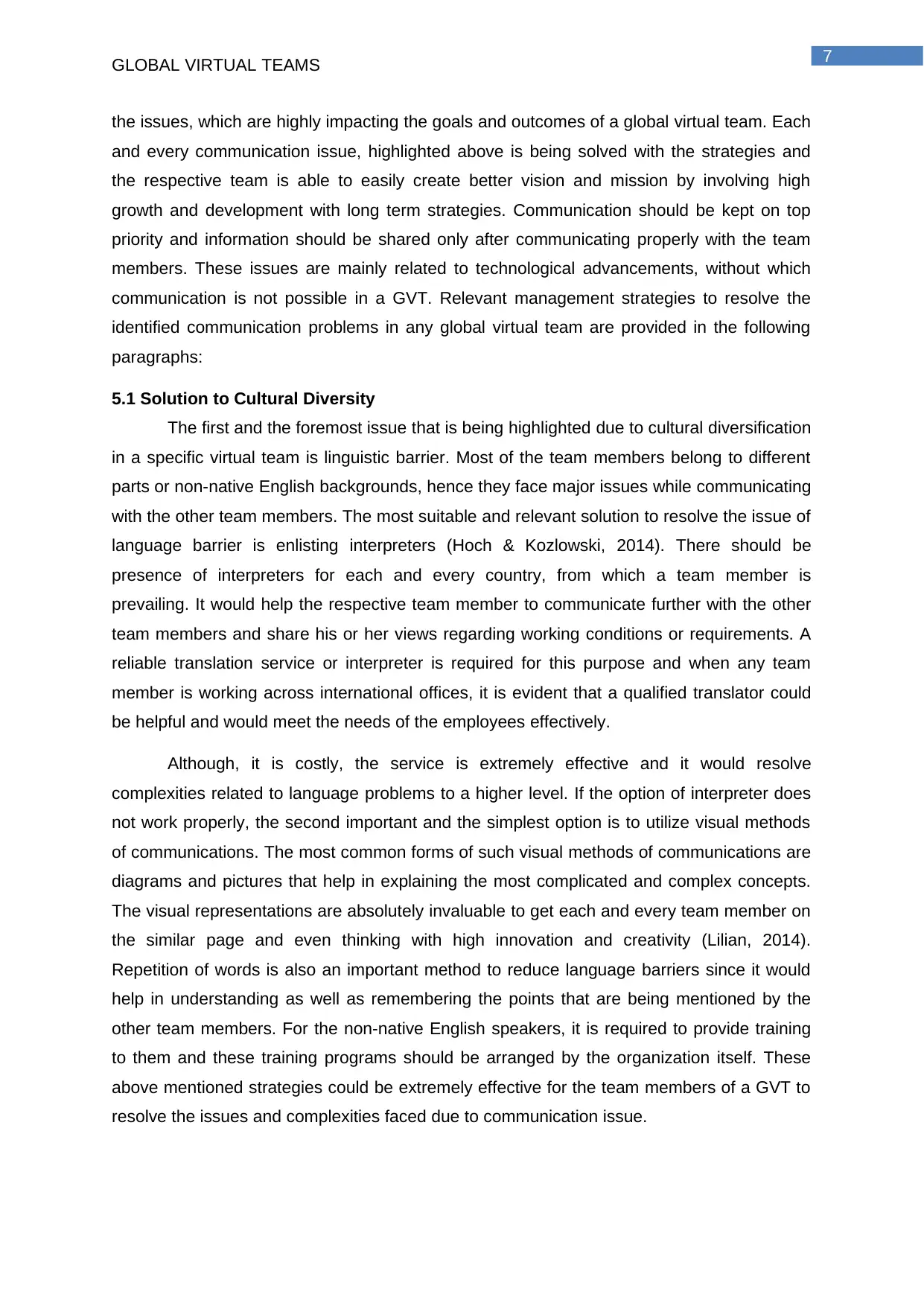
7
GLOBAL VIRTUAL TEAMS
the issues, which are highly impacting the goals and outcomes of a global virtual team. Each
and every communication issue, highlighted above is being solved with the strategies and
the respective team is able to easily create better vision and mission by involving high
growth and development with long term strategies. Communication should be kept on top
priority and information should be shared only after communicating properly with the team
members. These issues are mainly related to technological advancements, without which
communication is not possible in a GVT. Relevant management strategies to resolve the
identified communication problems in any global virtual team are provided in the following
paragraphs:
5.1 Solution to Cultural Diversity
The first and the foremost issue that is being highlighted due to cultural diversification
in a specific virtual team is linguistic barrier. Most of the team members belong to different
parts or non-native English backgrounds, hence they face major issues while communicating
with the other team members. The most suitable and relevant solution to resolve the issue of
language barrier is enlisting interpreters (Hoch & Kozlowski, 2014). There should be
presence of interpreters for each and every country, from which a team member is
prevailing. It would help the respective team member to communicate further with the other
team members and share his or her views regarding working conditions or requirements. A
reliable translation service or interpreter is required for this purpose and when any team
member is working across international offices, it is evident that a qualified translator could
be helpful and would meet the needs of the employees effectively.
Although, it is costly, the service is extremely effective and it would resolve
complexities related to language problems to a higher level. If the option of interpreter does
not work properly, the second important and the simplest option is to utilize visual methods
of communications. The most common forms of such visual methods of communications are
diagrams and pictures that help in explaining the most complicated and complex concepts.
The visual representations are absolutely invaluable to get each and every team member on
the similar page and even thinking with high innovation and creativity (Lilian, 2014).
Repetition of words is also an important method to reduce language barriers since it would
help in understanding as well as remembering the points that are being mentioned by the
other team members. For the non-native English speakers, it is required to provide training
to them and these training programs should be arranged by the organization itself. These
above mentioned strategies could be extremely effective for the team members of a GVT to
resolve the issues and complexities faced due to communication issue.
GLOBAL VIRTUAL TEAMS
the issues, which are highly impacting the goals and outcomes of a global virtual team. Each
and every communication issue, highlighted above is being solved with the strategies and
the respective team is able to easily create better vision and mission by involving high
growth and development with long term strategies. Communication should be kept on top
priority and information should be shared only after communicating properly with the team
members. These issues are mainly related to technological advancements, without which
communication is not possible in a GVT. Relevant management strategies to resolve the
identified communication problems in any global virtual team are provided in the following
paragraphs:
5.1 Solution to Cultural Diversity
The first and the foremost issue that is being highlighted due to cultural diversification
in a specific virtual team is linguistic barrier. Most of the team members belong to different
parts or non-native English backgrounds, hence they face major issues while communicating
with the other team members. The most suitable and relevant solution to resolve the issue of
language barrier is enlisting interpreters (Hoch & Kozlowski, 2014). There should be
presence of interpreters for each and every country, from which a team member is
prevailing. It would help the respective team member to communicate further with the other
team members and share his or her views regarding working conditions or requirements. A
reliable translation service or interpreter is required for this purpose and when any team
member is working across international offices, it is evident that a qualified translator could
be helpful and would meet the needs of the employees effectively.
Although, it is costly, the service is extremely effective and it would resolve
complexities related to language problems to a higher level. If the option of interpreter does
not work properly, the second important and the simplest option is to utilize visual methods
of communications. The most common forms of such visual methods of communications are
diagrams and pictures that help in explaining the most complicated and complex concepts.
The visual representations are absolutely invaluable to get each and every team member on
the similar page and even thinking with high innovation and creativity (Lilian, 2014).
Repetition of words is also an important method to reduce language barriers since it would
help in understanding as well as remembering the points that are being mentioned by the
other team members. For the non-native English speakers, it is required to provide training
to them and these training programs should be arranged by the organization itself. These
above mentioned strategies could be extremely effective for the team members of a GVT to
resolve the issues and complexities faced due to communication issue.
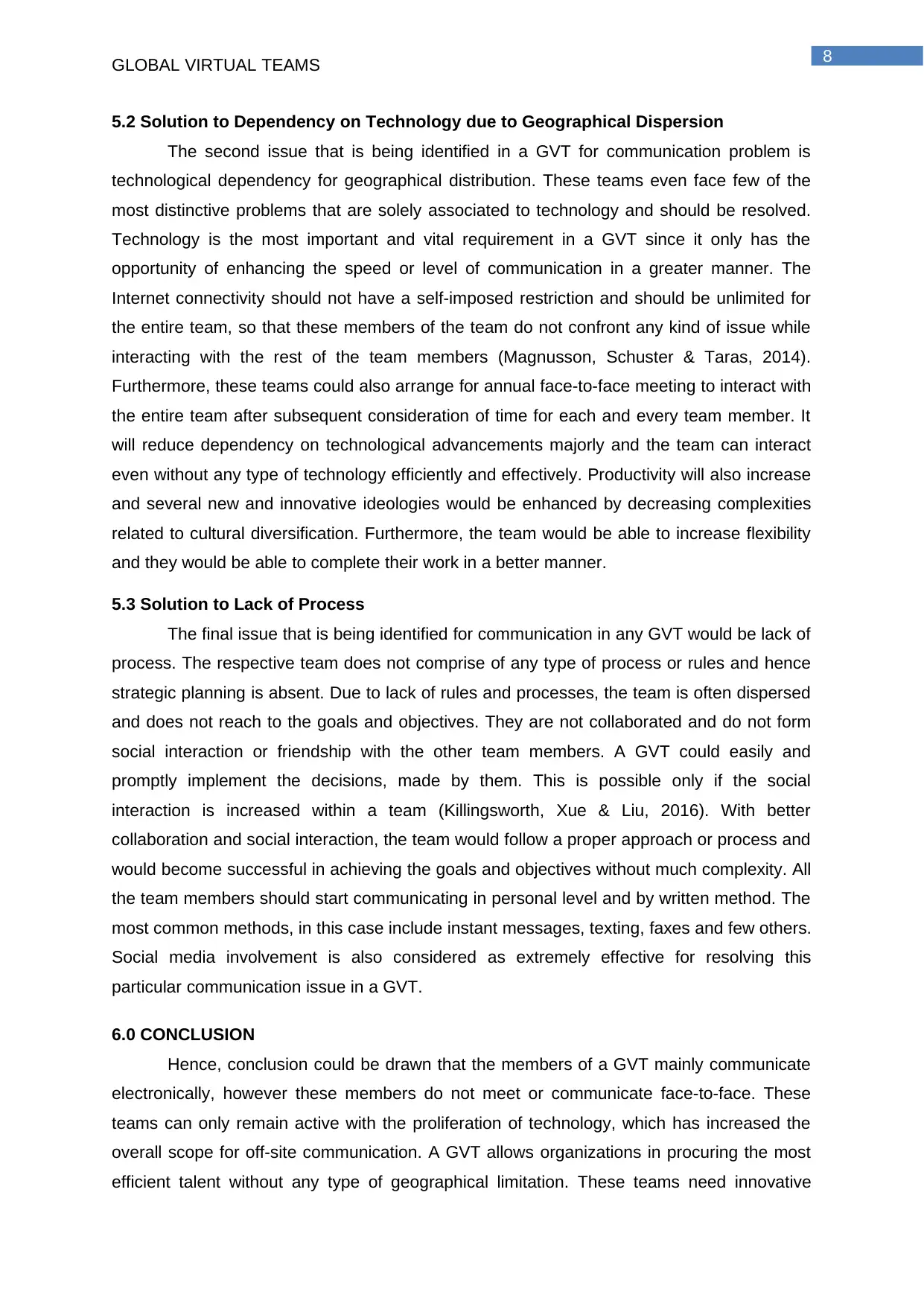
8
GLOBAL VIRTUAL TEAMS
5.2 Solution to Dependency on Technology due to Geographical Dispersion
The second issue that is being identified in a GVT for communication problem is
technological dependency for geographical distribution. These teams even face few of the
most distinctive problems that are solely associated to technology and should be resolved.
Technology is the most important and vital requirement in a GVT since it only has the
opportunity of enhancing the speed or level of communication in a greater manner. The
Internet connectivity should not have a self-imposed restriction and should be unlimited for
the entire team, so that these members of the team do not confront any kind of issue while
interacting with the rest of the team members (Magnusson, Schuster & Taras, 2014).
Furthermore, these teams could also arrange for annual face-to-face meeting to interact with
the entire team after subsequent consideration of time for each and every team member. It
will reduce dependency on technological advancements majorly and the team can interact
even without any type of technology efficiently and effectively. Productivity will also increase
and several new and innovative ideologies would be enhanced by decreasing complexities
related to cultural diversification. Furthermore, the team would be able to increase flexibility
and they would be able to complete their work in a better manner.
5.3 Solution to Lack of Process
The final issue that is being identified for communication in any GVT would be lack of
process. The respective team does not comprise of any type of process or rules and hence
strategic planning is absent. Due to lack of rules and processes, the team is often dispersed
and does not reach to the goals and objectives. They are not collaborated and do not form
social interaction or friendship with the other team members. A GVT could easily and
promptly implement the decisions, made by them. This is possible only if the social
interaction is increased within a team (Killingsworth, Xue & Liu, 2016). With better
collaboration and social interaction, the team would follow a proper approach or process and
would become successful in achieving the goals and objectives without much complexity. All
the team members should start communicating in personal level and by written method. The
most common methods, in this case include instant messages, texting, faxes and few others.
Social media involvement is also considered as extremely effective for resolving this
particular communication issue in a GVT.
6.0 CONCLUSION
Hence, conclusion could be drawn that the members of a GVT mainly communicate
electronically, however these members do not meet or communicate face-to-face. These
teams can only remain active with the proliferation of technology, which has increased the
overall scope for off-site communication. A GVT allows organizations in procuring the most
efficient talent without any type of geographical limitation. These teams need innovative
GLOBAL VIRTUAL TEAMS
5.2 Solution to Dependency on Technology due to Geographical Dispersion
The second issue that is being identified in a GVT for communication problem is
technological dependency for geographical distribution. These teams even face few of the
most distinctive problems that are solely associated to technology and should be resolved.
Technology is the most important and vital requirement in a GVT since it only has the
opportunity of enhancing the speed or level of communication in a greater manner. The
Internet connectivity should not have a self-imposed restriction and should be unlimited for
the entire team, so that these members of the team do not confront any kind of issue while
interacting with the rest of the team members (Magnusson, Schuster & Taras, 2014).
Furthermore, these teams could also arrange for annual face-to-face meeting to interact with
the entire team after subsequent consideration of time for each and every team member. It
will reduce dependency on technological advancements majorly and the team can interact
even without any type of technology efficiently and effectively. Productivity will also increase
and several new and innovative ideologies would be enhanced by decreasing complexities
related to cultural diversification. Furthermore, the team would be able to increase flexibility
and they would be able to complete their work in a better manner.
5.3 Solution to Lack of Process
The final issue that is being identified for communication in any GVT would be lack of
process. The respective team does not comprise of any type of process or rules and hence
strategic planning is absent. Due to lack of rules and processes, the team is often dispersed
and does not reach to the goals and objectives. They are not collaborated and do not form
social interaction or friendship with the other team members. A GVT could easily and
promptly implement the decisions, made by them. This is possible only if the social
interaction is increased within a team (Killingsworth, Xue & Liu, 2016). With better
collaboration and social interaction, the team would follow a proper approach or process and
would become successful in achieving the goals and objectives without much complexity. All
the team members should start communicating in personal level and by written method. The
most common methods, in this case include instant messages, texting, faxes and few others.
Social media involvement is also considered as extremely effective for resolving this
particular communication issue in a GVT.
6.0 CONCLUSION
Hence, conclusion could be drawn that the members of a GVT mainly communicate
electronically, however these members do not meet or communicate face-to-face. These
teams can only remain active with the proliferation of technology, which has increased the
overall scope for off-site communication. A GVT allows organizations in procuring the most
efficient talent without any type of geographical limitation. These teams need innovative
⊘ This is a preview!⊘
Do you want full access?
Subscribe today to unlock all pages.

Trusted by 1+ million students worldwide

9
GLOBAL VIRTUAL TEAMS
methods for working across different geographical locations with the help of processes,
people, systems and technologies, in spite of the increase in virtual teamwork. The above
report has properly outlined brief analyses over communication issues faced in GVTs, such
as cultural diversity, technology dependencies and lack of process with suitable
management strategies to resolve such issues.
GLOBAL VIRTUAL TEAMS
methods for working across different geographical locations with the help of processes,
people, systems and technologies, in spite of the increase in virtual teamwork. The above
report has properly outlined brief analyses over communication issues faced in GVTs, such
as cultural diversity, technology dependencies and lack of process with suitable
management strategies to resolve such issues.
Paraphrase This Document
Need a fresh take? Get an instant paraphrase of this document with our AI Paraphraser
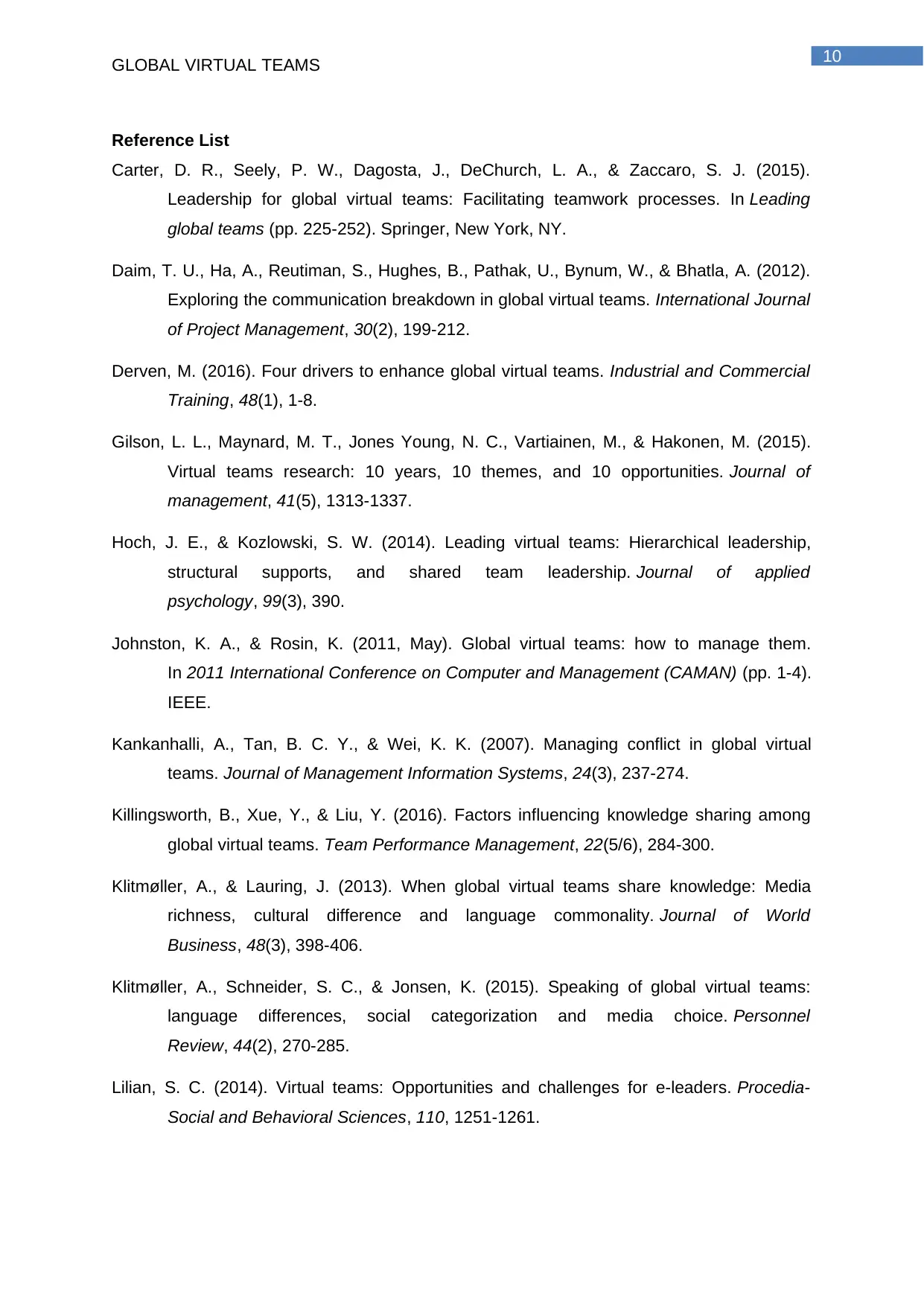
10
GLOBAL VIRTUAL TEAMS
Reference List
Carter, D. R., Seely, P. W., Dagosta, J., DeChurch, L. A., & Zaccaro, S. J. (2015).
Leadership for global virtual teams: Facilitating teamwork processes. In Leading
global teams (pp. 225-252). Springer, New York, NY.
Daim, T. U., Ha, A., Reutiman, S., Hughes, B., Pathak, U., Bynum, W., & Bhatla, A. (2012).
Exploring the communication breakdown in global virtual teams. International Journal
of Project Management, 30(2), 199-212.
Derven, M. (2016). Four drivers to enhance global virtual teams. Industrial and Commercial
Training, 48(1), 1-8.
Gilson, L. L., Maynard, M. T., Jones Young, N. C., Vartiainen, M., & Hakonen, M. (2015).
Virtual teams research: 10 years, 10 themes, and 10 opportunities. Journal of
management, 41(5), 1313-1337.
Hoch, J. E., & Kozlowski, S. W. (2014). Leading virtual teams: Hierarchical leadership,
structural supports, and shared team leadership. Journal of applied
psychology, 99(3), 390.
Johnston, K. A., & Rosin, K. (2011, May). Global virtual teams: how to manage them.
In 2011 International Conference on Computer and Management (CAMAN) (pp. 1-4).
IEEE.
Kankanhalli, A., Tan, B. C. Y., & Wei, K. K. (2007). Managing conflict in global virtual
teams. Journal of Management Information Systems, 24(3), 237-274.
Killingsworth, B., Xue, Y., & Liu, Y. (2016). Factors influencing knowledge sharing among
global virtual teams. Team Performance Management, 22(5/6), 284-300.
Klitmøller, A., & Lauring, J. (2013). When global virtual teams share knowledge: Media
richness, cultural difference and language commonality. Journal of World
Business, 48(3), 398-406.
Klitmøller, A., Schneider, S. C., & Jonsen, K. (2015). Speaking of global virtual teams:
language differences, social categorization and media choice. Personnel
Review, 44(2), 270-285.
Lilian, S. C. (2014). Virtual teams: Opportunities and challenges for e-leaders. Procedia-
Social and Behavioral Sciences, 110, 1251-1261.
GLOBAL VIRTUAL TEAMS
Reference List
Carter, D. R., Seely, P. W., Dagosta, J., DeChurch, L. A., & Zaccaro, S. J. (2015).
Leadership for global virtual teams: Facilitating teamwork processes. In Leading
global teams (pp. 225-252). Springer, New York, NY.
Daim, T. U., Ha, A., Reutiman, S., Hughes, B., Pathak, U., Bynum, W., & Bhatla, A. (2012).
Exploring the communication breakdown in global virtual teams. International Journal
of Project Management, 30(2), 199-212.
Derven, M. (2016). Four drivers to enhance global virtual teams. Industrial and Commercial
Training, 48(1), 1-8.
Gilson, L. L., Maynard, M. T., Jones Young, N. C., Vartiainen, M., & Hakonen, M. (2015).
Virtual teams research: 10 years, 10 themes, and 10 opportunities. Journal of
management, 41(5), 1313-1337.
Hoch, J. E., & Kozlowski, S. W. (2014). Leading virtual teams: Hierarchical leadership,
structural supports, and shared team leadership. Journal of applied
psychology, 99(3), 390.
Johnston, K. A., & Rosin, K. (2011, May). Global virtual teams: how to manage them.
In 2011 International Conference on Computer and Management (CAMAN) (pp. 1-4).
IEEE.
Kankanhalli, A., Tan, B. C. Y., & Wei, K. K. (2007). Managing conflict in global virtual
teams. Journal of Management Information Systems, 24(3), 237-274.
Killingsworth, B., Xue, Y., & Liu, Y. (2016). Factors influencing knowledge sharing among
global virtual teams. Team Performance Management, 22(5/6), 284-300.
Klitmøller, A., & Lauring, J. (2013). When global virtual teams share knowledge: Media
richness, cultural difference and language commonality. Journal of World
Business, 48(3), 398-406.
Klitmøller, A., Schneider, S. C., & Jonsen, K. (2015). Speaking of global virtual teams:
language differences, social categorization and media choice. Personnel
Review, 44(2), 270-285.
Lilian, S. C. (2014). Virtual teams: Opportunities and challenges for e-leaders. Procedia-
Social and Behavioral Sciences, 110, 1251-1261.
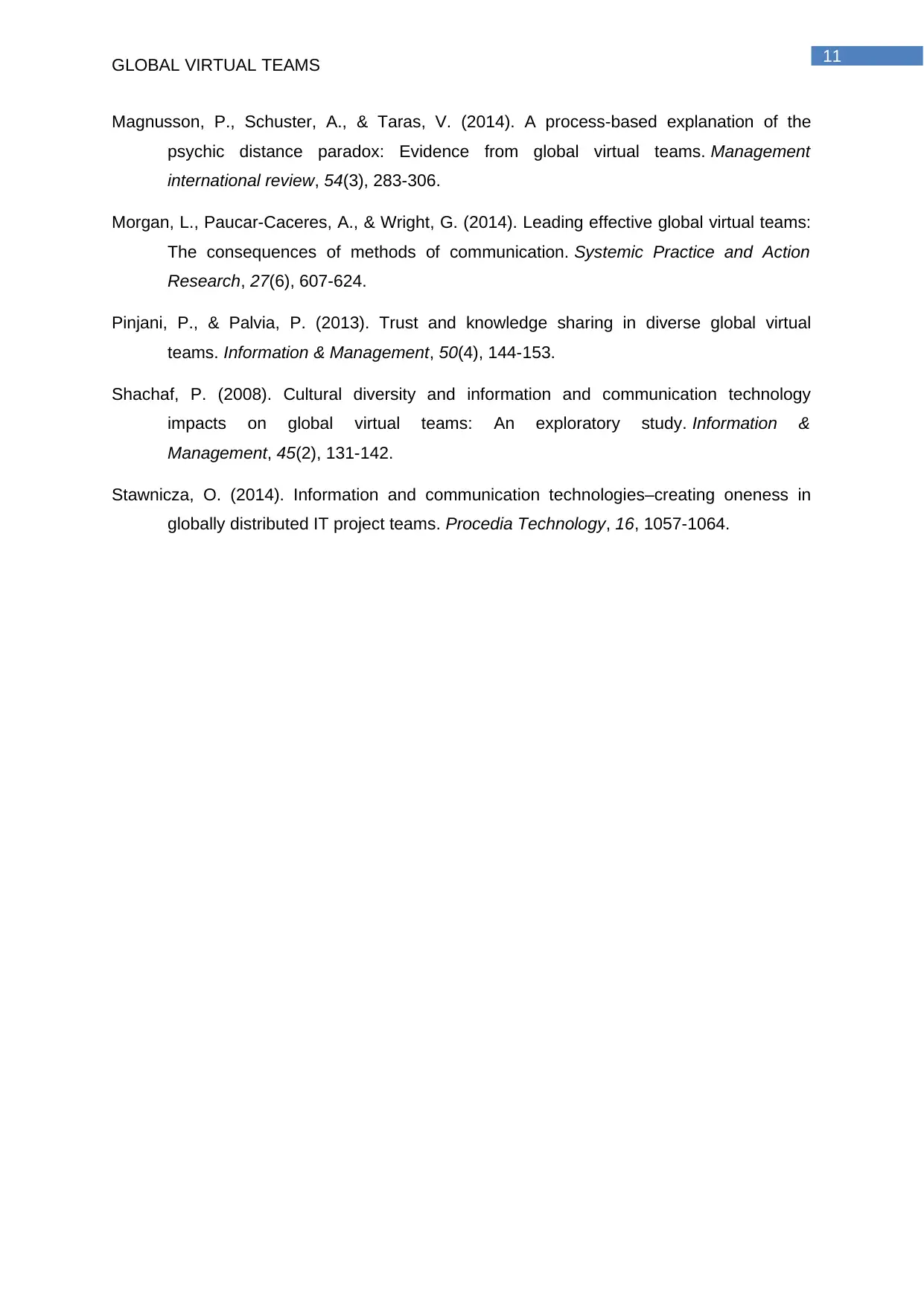
11
GLOBAL VIRTUAL TEAMS
Magnusson, P., Schuster, A., & Taras, V. (2014). A process-based explanation of the
psychic distance paradox: Evidence from global virtual teams. Management
international review, 54(3), 283-306.
Morgan, L., Paucar-Caceres, A., & Wright, G. (2014). Leading effective global virtual teams:
The consequences of methods of communication. Systemic Practice and Action
Research, 27(6), 607-624.
Pinjani, P., & Palvia, P. (2013). Trust and knowledge sharing in diverse global virtual
teams. Information & Management, 50(4), 144-153.
Shachaf, P. (2008). Cultural diversity and information and communication technology
impacts on global virtual teams: An exploratory study. Information &
Management, 45(2), 131-142.
Stawnicza, O. (2014). Information and communication technologies–creating oneness in
globally distributed IT project teams. Procedia Technology, 16, 1057-1064.
GLOBAL VIRTUAL TEAMS
Magnusson, P., Schuster, A., & Taras, V. (2014). A process-based explanation of the
psychic distance paradox: Evidence from global virtual teams. Management
international review, 54(3), 283-306.
Morgan, L., Paucar-Caceres, A., & Wright, G. (2014). Leading effective global virtual teams:
The consequences of methods of communication. Systemic Practice and Action
Research, 27(6), 607-624.
Pinjani, P., & Palvia, P. (2013). Trust and knowledge sharing in diverse global virtual
teams. Information & Management, 50(4), 144-153.
Shachaf, P. (2008). Cultural diversity and information and communication technology
impacts on global virtual teams: An exploratory study. Information &
Management, 45(2), 131-142.
Stawnicza, O. (2014). Information and communication technologies–creating oneness in
globally distributed IT project teams. Procedia Technology, 16, 1057-1064.
⊘ This is a preview!⊘
Do you want full access?
Subscribe today to unlock all pages.

Trusted by 1+ million students worldwide
1 out of 12
Related Documents
Your All-in-One AI-Powered Toolkit for Academic Success.
+13062052269
info@desklib.com
Available 24*7 on WhatsApp / Email
![[object Object]](/_next/static/media/star-bottom.7253800d.svg)
Unlock your academic potential
Copyright © 2020–2025 A2Z Services. All Rights Reserved. Developed and managed by ZUCOL.





